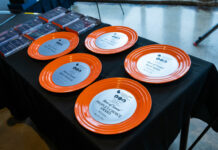As i make my way to the restroom at Golden West in Hampden, I get a text from Rebecca Klein Scott, one of the body language experts I’m here to meet. She’s in a booth I’d walked by seconds before.
“I had a feeling it was you when I saw you just now,” she says as I slide into the seat opposite hers—and I admit that makes me feel a teeny drop extra self-conscious straight off the bat.
Klein Scott is the petite component of TALLsmall Productions, the company she partners in with her 6-foot-9-inches tall husband, Keith Scott, who sits beside her on the same side of the booth, where they remain for the duration of our interview. The two were doing communications consulting work when they met in 2013 on LinkedIn. They’ve since made it their business to help all manner of workplaces—including Johns Hopkins dermatology, Giant Food and the National Aquarium—to empower their employees via body language and communication analysis.
“Most people don’t pay attention to body language,” Klein Scott says. “My favorite [teaching tool] is an activity we do to coach people on how to deliver an elevator introduction that catches people off guard and doesn’t resemble the robotic intros most folks use.”
“My favorite activity is allowing people to understand how many ‘filler words’ they use on a daily basis,” Keith Scott says. In addition to the obvious “ums” and “likes”—both which are employed more often by women than men—plumping up our speech with qualifiers such as “in my opinion” and “really” can betray a lack of confidence in what we’re saying.
The duo believes their greatest strength lies in coaching clients to “find their authentic voices” (both physical and verbal) Klein Scott explains, “and to learn how to use them effectively.”
I can’t resist asking the couple to do their thing and analyze a table of six about five feet from ours.
“We do this all the time, just for fun,” Scott tells me. They promptly tell me about the diners’ moods and relationships, and it makes sense. The woman at the head of the table is “bored” and generally has a negative attitude, as evidenced by her folded arms, her thrown-back posture and blank facial expression. Scott goes on to note that only two of the other diners appear to be enjoying one another’s company: Their arms rest easily on the table before them, and they hold eye contact.
Have Tall and Small tapped into my longstanding social anxiety? I ask if they can pinpoint any nonverbal cues that convey nerves.
“You’ve been twisting a lock of your hair,” Scott says, giving me bigger flapping butterflies. But they also can tell that I’m open to this experience because my hands are resting on the table in front of me as I meet their gaze.
What makes sense: I can definitely understand why employers would find it helpful to learn to use and interpret nonverbal language. It’s common in the workplace to display emotions we’d never demonstrate verbally—insecurity, disinterest, even dishonesty.
What increases my personal anxiety: The experts’ own unspoken interaction is decidedly theatrical (polished and charming but quite performative-feeling), and I sometimes feel like I’ve stumbled onto the set of a popular morning talk show during our time together. Maybe this rehearsed “voice” is the one they’ve searched for and claimed, I don’t know—but, frankly, I’m a little too timid to come right out and ask.




